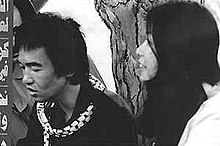This is an old revision of this page, as edited by Arminden (talk | contribs) at 10:01, 27 November 2017 (Cut the BS. Terrorist, not militant - has killed civilians in terror attack, that's the definition for a terrorist.). The present address (URL) is a permanent link to this revision, which may differ significantly from the current revision.
Revision as of 10:01, 27 November 2017 by Arminden (talk | contribs) (Cut the BS. Terrorist, not militant - has killed civilians in terror attack, that's the definition for a terrorist.)(diff) ← Previous revision | Latest revision (diff) | Newer revision → (diff)| Kōzō Okamoto | |
|---|---|
 Kōzō Okamoto (left) and Fusako Shigenobu, leader of the Japanese Red Army at a press conference Kōzō Okamoto (left) and Fusako Shigenobu, leader of the Japanese Red Army at a press conference | |
| Born | (1947-12-07) December 7, 1947 (age 77) Kumamoto, Japan |
| Nationality | Japanese |
| Known for | Japanese Red Army |
Kōzō Okamoto (岡本 公三, Okamoto Kōzō, born in Kumamoto, Japan, on December 7, 1947) is a Japanese former communist terrorist and member of the Japanese Red Army (JRA).
Okamoto was a 24-year-old botany student from a middle-class family when he was recruited to the Japanese Red Army. He was later detained in Lebanon. During his stay in Lebanon, Okamoto converted to Islam. He is wanted by the government of Japan for his activities with the Red Army, and was imprisoned by Israel for his involvement in the Lod Airport massacre.
Participation in terrorism
Main article: Lod Airport massacreOn May 30, 1972, Kōzō Okamoto along with Yasuyuki Yasuda, and Tsuyoshi Okudaira, arrived at Israel's Lod Airport in Tel Aviv, via Air France Flight 132 from Rome. After disembarking from the plane the three members of the JRA proceeded to the baggage claim area. Upon retrieving their luggage, they took out automatic weapons packed inside the suitcases and opened fire on other passengers in the baggage claim area.
The attack was a joint operation of the Popular Front for the Liberation of Palestine – External Operations (PFLP-EO), and the Japanese Red Army. The idea behind the joint effort was for the JRA to carry out attacks for the PLFP, and vice versa, in order to reduce suspicion. The plan worked, as Okamoto and his comrades attracted little attention prior to their attack.
They killed 26 people and injured 71 others. Yasuyuki Yasuda was accidentally shot dead by one of the other attackers. Tsuyoshi Okudaira was killed by one of his own grenades, either due to accidental premature explosion or as a suicide. Kōzō Okamoto was wounded and captured trying to escape the terminal. The attack became known as the Lod Airport massacre.
Trial and release
Okamoto was tried in an Israeli military court under the 1948 Emergency Regulations. His court-appointed lawyers were Max Kritzman and David Rotlevy. Chicago-born and British-trained Kritzman, who was chief lawyer, had experience defending Israelis charged under the Emergency Regulations. Of Okamoto, he complained that "this man will not cooperate." Okamoto pleaded guilty, ensuring that he did not get sentenced to death. He also undermined his own defense, protesting his attorneys' requests for a psychiatric evaluation.
Kōzō Okamoto was convicted and sentenced to life imprisonment in Israel. During the incarceration it is said that he requested to convert to Judaism, and that he tried to circumcise himself with nail clippers. On July 23, 1973, PFLP and JRA operatives hijacked Japan Air Lines Flight 404, demanding Okamoto's release in exchange for the hostages on board; Israel refused to comply. Okamoto was released in 1985 after 13 years in prison, as part of a prisoner exchange with Palestinian militant factions for captive Israeli soldiers. After his release from prison in Israel, Kōzō Okamoto moved to Libya, then Syria, and finally to Lebanon where he reunited with other members of the Japanese Red Army.
Transfer to Lebanon
On February 15, 1997, Lebanon detained five Red Army members, Haruo Wakō, Masao Adachi, Mariko Yamamoto, Kazuo Tohira and Kōzō Okamoto for using forged passports and visa violations. They were sentenced to three years in prison. The sentence was passed by Judge Soheil Abdul-Sams on July 31, 1997. After their prison term was completed, the four other members of the JRA were forcibly deported to Jordan and from Amman, Jordan via a chartered Russian plane to Japan. The Lebanese government, however, granted political asylum to Kōzō Okamoto because, according to the Lebanese government, he "had participated in resistance operations against Israel and had been tortured in Israeli jails."
Kōzō Okamoto is still wanted by the Japanese government and Japan has requested his extradition. As of 2016 he was reported to be living in a refugee camp near Beirut.
Films
Rabih El-Amine's 1999 documentary Ahmad the Japanese, Lod-Roumié-Tokyo tells Okamoto's story from the perspective of five major personalities that knew him in Beirut.
References
- LaPierre (1999), p. 202.
- "Red Army guerrillas arrested". BBC.com. 18 March 2000. Retrieved September 6, 2011.
- Mark Schreiber (1996). Shocking crimes of postwar Japan. Tuttle Publishing. p. 215. ISBN 978-4-900737-34-1. Retrieved 6 September 2011.
- Schreiber, p. 215
- "ISRAEL: Terrorist on Trial". Time. July 24, 1972.
- "How the terrorist who attacked Israel's main airport escaped the death penalty". Retrieved 24 September 2012.
- "Japanese Red Army member Okamoto wants to return to Japan". Lebanonwire. May 6, 2003. Retrieved September 6, 2011.
{{cite news}}: Cite has empty unknown parameter:|coauthors=(help) - Press Conference The Ministry of Foreign Affairs of Japan 21 March 2000
- "Japanese Red Army member Kozo Okamoto living quietly in Lebanon refugee camp". The Japan Times. December 26, 2016. Retrieved January 29, 2017.
External links
- Press Conference The Ministry of Foreign Affairs of Japan 21 March 2000. Regarding the arrest of members of the JRA.
- The Terrorist Attack on Lod Airport: 40 Years After,King Hussein Expresses Sympathy, the Government Considers the Death Penalty, Israel State Archives